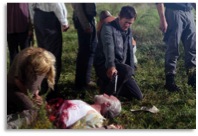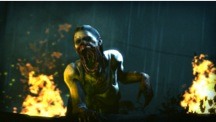Click here to read Lucas’ Inquiry 2A.
To see how Lucas uses this topic for Inquiry 3 (Creative and Critical Application), click here.
Writer’s Reflection
This project has defiantly been a labor of love. I mean honestly, how often does one get to write about zombies for an academic paper? When I first learned about this, I thought it was going to be another paper that I put a half-hearted effort into but I was pleasantly surprised. I sat down to brainstorm ideas on genres that I could analyze. First looking to the Adventure or Fantasy genres, as I have started writing a story of my own in this category. I soon realized that this didn’t interest me as much as I had hoped, so I began to think…what is something that grabs my undivided attention and is something I could deal with for several weeks? My answer: Zombies.
Overall I think the paper accomplishes its goal. I look at where zombies have come from and where they have gone, what types of media they are in and the roles they play for fans of the undead. I also look at how they connect with the apocalypse, yet give add their own spice to the mix. I know this could be better, as most papers can always improve, but this is a work I can say with confidence is one of my best pieces of work. With all the hours and research I put into this, I hope this paper will shed as much light on these undead horrors for others as it did for me.
***
The end of the world has been a subject that many people have debated all throughout history, fascinating many and causing them to come up with alternative outcomes to the Armageddon. One such alternative is the possibility of a worldwide epidemic known as the Undead. Human bodies reanimating after death to kill off any living creature it comes into contact with, this is where one genre of stories and media begins: Zombies.
Zombies have been an icon for people around the world for death, destruction, and the end of the human world, as we know it. Before stepping into the actual genre, one must first understand: What exactly is a Zombie? According to The Zombie Survival Guide by Max Brooks, Zombies are “animated corpses that feed on living human flesh” (1). Typically created by a virus strain, zombies are self-sufficient, relentless killing machines that strike fear and terror into the hearts of many. Curiously enough, zombies didn’t originate as the blood-thirsty monstrosities we know today: the modern ‘Zombie’ is derived from African Voodoo cults, where witchcraft was used to resurrect or reanimate a person killed with black magic. Theses ‘living dead’ would then preform any acts, typically hard labor, given to them like a mindless machine, emotionless and unable to communicate as their tongues were often removed (Martí 3-4). Now, what caused this gruesome transformation from the harmless, spellbound tribesmen to the ravenous carnivores that have made such an impression in modern society? Perhaps it was the need for a truly frightening creature, one that doesn’t hesitate to kill, that doesn’t have emotional ties to this world, and that will stop at nothing to sink it’s teeth into helpless prey, in other words: the perfect killing machine.
Now, we humans have a natural fascination with the unknown and the unnatural; which is the niche zombies have stumbled into. Recreated by modern storytellers, the zombies of today’s fiction have been transformed to not only fit the category of horror and terrifying monsters, but the stories surrounding them have captivated audiences with a combination of intensity and suspense. Stories of survivors thrown into a post-apocalyptic world, stranded amongst hordes of zombies with only the slight possibility of salvation as their drive to continue. However, there are other stories of survivors trapped in desolate places with the threat of death, what makes zombie stories any different?
Many factors contribute to the success of rising zombie media; one thing Dickson talks about in her article is the feeling of “safe” fear, which grabs the attention of many; enabling audiences to experience adrenaline pumping excitement and terror while from the comfort of their imagination (117-118). Dropped into a post-apocalyptic world, the survivors of these stories must ward off hordes of zombies while waiting for some form of salvation: a cure, military protection, and even death. As shown in Figure 1, the main protagonist in Dead Rising 2, Chuck Greene, is surrounded by an approaching horde of zombies while only armed with a wrench to fend them off. In this situation, players can experience an adrenaline rush while trying to keep the hero alive while sitting comfortably on the sideline.
Another thing these stories offer are the imminent threats of violent deaths, the collapse of societal infrastructures, fantasies of banded survivors and the fear of other surviving humans (Bishop 20). Knowing that at any moment the characters that have become fan-favorites could be killed and turned into the very creatures they sought out to destroy. A point clearly demonstrated by Figure 2, where Daryl Dixon (Norman Reedus) must put down fellow group member Dale Horvath (Jeffery DeMunn) after having been torn into by a zombie before he is allowed to expire and reanimate. This tragic event forces the survivors to face the realization that they may have to cut all emotional ties to both the living and the dead. These stories offer fears that other genres fail to even touch, such as: the possibility of having loved ones being ripped away and being eaten alive, having to put down friends met along the way, and even having the painful choice of eliminating reanimated loved ones or letting them roam only to kill other unsuspecting survivors.
A third factor that has attributed to the success is the fact that over the last thirty years, zombies have gone from pasty faced ghouls to half-eaten, decaying corpses that resort to cannibalizing any living human it comes into contact with (Bishop 21). This change in appearance has allowed for zombies to become a more terrifying horror icon permitting for more gruesome tales, but also antagonists the audience can come to love and loathe at the same time. With the rise in zombie-based videogames, this ghastly transformation has allowed players to experience a more realistic atmosphere of death and decay all while traveling through new environments and battling against the hordes of undead. Over the years, zombies have become a favored killing target for gamers of all sorts, being featured in games such as: Dead Rising, Left 4 Dead and even non-zombie centered games such as Call of Duty. They have become favored over other prey as zombies are slow moving, incapable of reasoning or problem solving, and are relatively easy to kill. Players can even take over the zombies’ role, as they slaughter hordes of helpless undead and in some games, even play as a member of the undead army. The graphicness of their appearance, missing limbs, splattering organs and blood, and decaying faces only add to the gratification of exterminating these flesh-craving monsters.
The creators of these gruesome tales generate situations that not only help the audience become enveloped in character development and plot, but also bring to life the dangers of living in a world overrun with the dead. Allowing audiences to follow everyday people through a chaotic, lawless wasteland, they become engaged in the characters new lives and their personal as well as moral development as they travel through a world ruled by the dead. Many television shows and videogames have surfaced in order to satisfy the need for firsthand encounters with the undead in a post apocalyptic world. Shows like AMC’s The Walking Dead and videogames such as Left 4 Dead, Dead Rising, and Dead Island all take audiences through the zombie-infested lands firsthand. Allowing for up-close and personal interactions with zombies, the viewer or player gets to see what it would be like to come face-to-face with zombies and make decisions that alter the lives of the survivors. Stepping into the world of zombies, audiences get to feel the direct effects of the phenomenon humans have feared for centuries, the end of modern civilization. Figure 3 demonstrates what fanatics of the undead look forward to when it comes to a complete zombie takeover. A grotesque female zombie crawling in search of prey while the world around her goes up in flames. It is situations like this where people find themselves asking what happened to the world they once knew or what will become of them?
This leads us to a worldwide demise we know as the apocalypse; however, no one is certain of how or when this desolation will occur. One of the more popular beliefs, prophesied by the Mayans, is that on December 21st, 2012 the world will come to an abrupt end. There have been various predictions at when our demise will come, but none thus far have been fruitful and hopefully none ever will. Whether this will ever happen or not, in his article, Bishop notices that nation wide paranoia seems to spike right after major catastrophes such as the attacks of September 11th, 2001. Continuing on this pattern, he found that zombie-based media flourished around this time, when people had fear of terrorist attacks. The zombies portrayed as outsiders threatening the American way of life and everything we hold dear, and thriving on the fact that American’s are not as safe as they once believed (17). However, not all zombies are portrayed in this fashion and the category of zombies offers alternatives to the worldwide phenomenon known as the apocalypse. The zombie apocalypse: a desolate reality where the forsaken outnumber the living and all hope is lost.
The apocalypse is a frightening thought, one that seems to have become intertwined with zombies and all the havoc they wreak. The idea of former humans walking the earth, devouring loved ones and strangers alike like mindless animals; this is just a snapshot of what human extinction could look like if the world of zombies came to fruition. Within the realm of zombies, death not only brings about the end of life but also the beginning of a new chapter. Hordes of once friendly faces staggering down the street in search of warm flesh while survivors succumb to societal collapse and total chaos. In essence, a zombie apocalypse would lead to the downfall of mankind while a new, more dangerous species rises to supremacy.
Works Cited
Bishop, Kyle. “Dead Man Still Walking.” Journal Of Popular Film & Television 37.1 (2009): 16-25. Academic Search Complete. Web. 24 Feb. 2012.
Brooks, Max. The Zombie Survival Guide. New York: Three Rivers Press, 2003. Print.
Burnes, Andrew. Left 4 Dead 2 Intro Cinematic. Digital image. Voodoo Extreme. IGN, 22 Oct. 2009. Web. 17 Mar. 2012. <http://ve3d.ign.com/articles/news/50920/Watch-The-Awesome-Left-4-Dead-2-Intro-Cinematic-Right-Here-Right-Now>.
Dickson, Randi. “Horror: To Gratify, Not Edify.” Language Arts Nov. 1998: 115. Academic Search Complete. Web. 29 Feb. 2012.
Martí, Josep. “Witchcraft Between Tradition And Modernity: The Ekong Case In Equatorial Guinea.” Scientific Journal Of Humanistic Studies 3.5 (2011): 1-11. Academic Search Complete. Web. 28 Feb. 2012.
Page, Gene. Episode 11 Daryl Python. Digital image. Walking Dead Wiki. AMCtv.com, 5 Mar. 2012. Web. 16 Mar. 2012. <http://walkingdead.wikia.com/wiki/File:Episode-11-daryl-python.jpg>.
Stratton, Jon. “Zombie Trouble: Zombie Texts, Bare Life And Displaced People.” European Journal Of Cultural Studies 14.3 (2011): 265-281. Academic Search Complete. Web. 25 Feb. 2012.
Teti, John. Digital image. Www.G4tv.com. NBCUniversal, 15 Sept. 2010. Web. 16 Mar. 2012. <http://files.g4tv.com/ImageDb3/250775_S/Dead-Rising-Case-West.jpg>.



